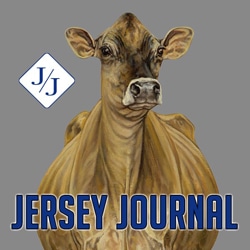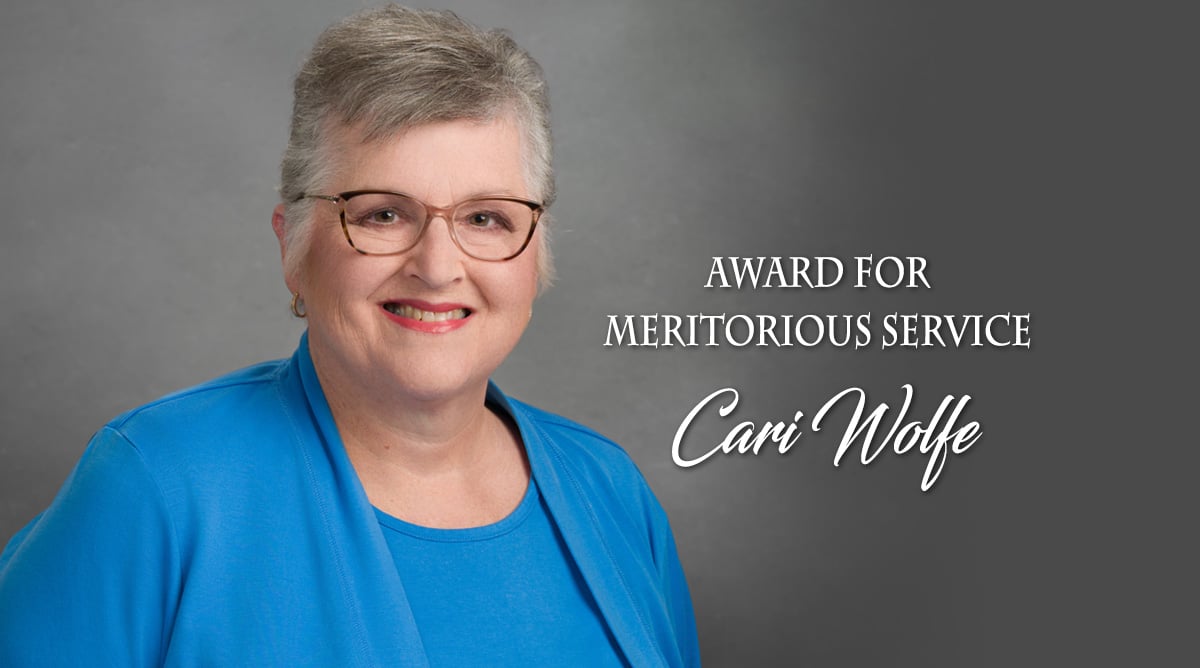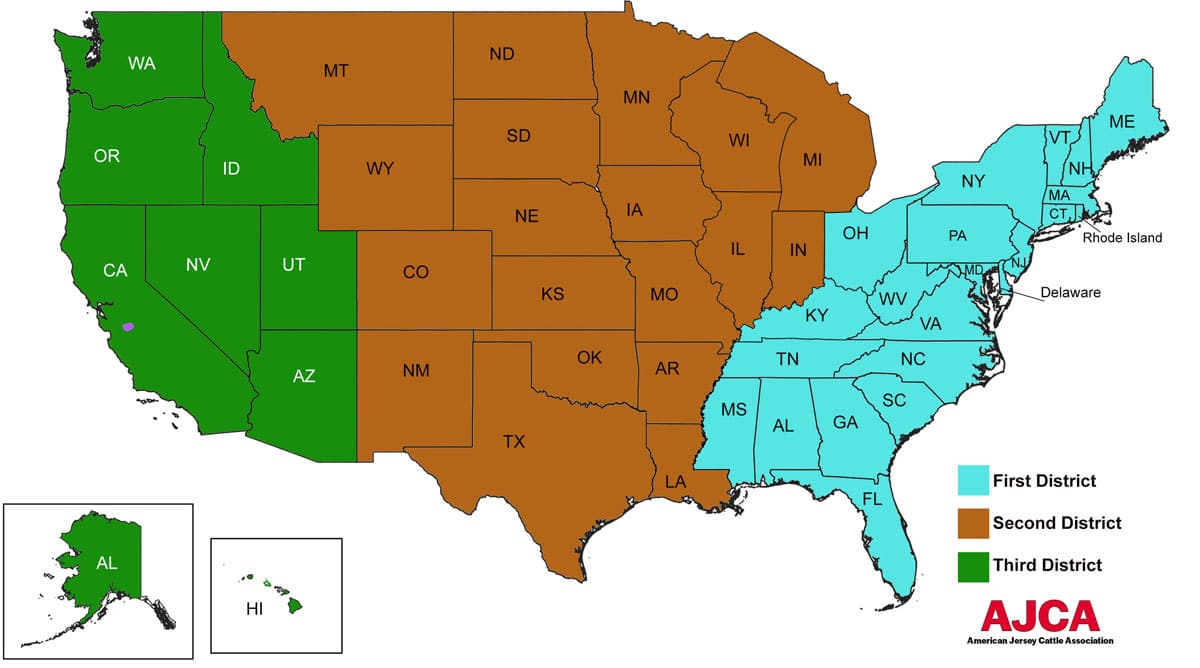Jersey Organizations Recognize Cari Wolfe with Meritorious Service Award
Cari Wolfe, Reynoldsburg, Ohio, has been named a recipient of the Award for Meritorious Service presented by the American Jersey Cattle Association (AJCA) and National All-Jersey Inc. (NAJ).
This award is given annually to a living individual(s) who, in the joint opinion of the Boards of Directors of the national Jersey organizations, has made a notable contribution to the advancement of the Jersey breed and the livelihood of Jersey owners in the United States through research, education, development, marketing, or other significant activities of the allied dairy industry.
It is unusual for anyone these days to stick with a job more than a few years, and inconceivable that someone would do it for 40 years, with the same employer. But that is exactly what Cari Wolfe did as an employee of the national Jersey organizations from January 1982 to June 2022.
Though she held various positions and wore many hats, Cari’s most impactful role was as genetics tactician. She worked with purpose, and a mission to develop science-based tools to improve genetics and, through them, the productivity and profitability of the Jersey cow.
As genetic improvement coordinator, and then director of research and genetic program development, Cari guided Jersey leaders as they adopted policies and set goals. She helped staff and industry partners develop and update genetic tools and educated Jersey breeders on how to apply them. Cari was the face of Jersey for collaborative work with high-level allied industry partners like USDA’s Animal Improvement Programs Laboratory (AIPL) and its Bovine Functional Genomics Laboratory, which merged in 2014 to become the Animal Genomics and Improvement Laboratory; the National Association of Animal Breeders; the Council on Dairy Cattle Breeding; DHI; and a host of dairy research universities.
A pragmatist equipped with dairy experience, education and connections, Cari could differentiate a realistic goal from a pipe dream, knew what questions to ask of whom, and made things happen. She understood the significance, challenge—and permanence—of genetic choices that were irreversible and could not be measured for a good three to four years after they were made.
So, what would drive someone to work more than 10,000 days for a single cause? For Cari, working for the Jersey cow and her owner breeders was a labor of love.
“If there has ever been a person who loved the Jersey cow more than Cari Wolfe, I don’t know where to find them,” wrote Dr. H. Duane Norman, whose 42-year career as a research geneticist for USDA’s Agricultural Research Service included extensive collaboration with Cari and the Jersey association. Over the years, she served on numerous industry committees and met with countless industry groups, and in every case, made sure the perspective of the Jersey breed was considered, summed the recipient of the AJCC Distinguished Service Award (1990).
The Jersey bug was transmitted to Cari through her Grandpa Hodge, who bred Registered Jerseys in New Jersey in the 1940s, and mother, Nancy, who even showed at the All American Jersey Show. After her parents, Nancy and Jerry Weinberg, both teachers, wed and began raising their family, they continued to raise Registered Jerseys with Cari and her four siblings in New Jersey and breeding them with the prefix Jer-Nan.
A Jersey breeder who helped to shape Cari’s career and stance on production and profitability was Doris Hough, who operated Milknhoney Farm in New Jersey with her husband, George. Though Cari cannot recall the purpose of a visit she and her mother paid Mrs. Hough, she vividly remembers what ensued. Mrs. Hough pulled a Jersey Journal from the cab of the pickup, spread it on the hood, and showed her how to read bull proofs, with emphasis on pluses and minuses.
The lesson stuck with Cari, who soon put the knowledge to work. She stopped by the ABS booth at the Pennsylvania All-American Dairy Show while she was there competing with the state 4-H dairy judging team and purchased a cane of Milestones Generator. She mated her 4-H cow to “Generator” and was blessed with a pair of full sisters that both outperformed their dam. Cari was hooked on the power of genetics.
The younger of those two “Generator” daughters was the pathway to a lifelong friendship with the Robert Stiles family, who granted “Perky” rights to be tied in with the Waverly Farm show string at The All American Jersey Show in 1977. It was the first time Cari showed on the green shavings in Louisville, Ky., and the beginning of a long relationship with the Stiles family and All American, which included cheering on her own daughter, Rebecca, from ringside in 2000.
There were other mentors in the early years too. Combine this list with that of future colleagues and you could publish a “Who’s Who” of the U.S. dairy industry. While at Virginia Tech for her undergraduate studies, she was advised by Dr. William Etgen and Dr. John White. At North Carolina State University, where she completed her master’s degree in animal science in 1981, she worked with Dr. Benjamin McDaniel and Dr. John Wilk.
Cari’s master’s research analyzed the correlated response of type traits to selection for milk yield using data from NC State’s highly regarded Randleigh Jerseys. She also evaluated Jersey linear type traits data shortly after the industry-wide program was adopted in 1980, a step that ultimately led to the formula now used to calculate Jersey final score. The work initiated a career-long association with the type traits program. Over the years, Cari crunched reams of data to identify breed trends, evaluate appraiser performance, and steer the Type Advisory Committee, with goals to improve accuracy and improve functional type.
Cari was hired by the national Jersey organizations as Southeast area representative in January 1982. The first woman to work in the field, her effectiveness opened doors for other well-trained, talented women to follow. Jersey employment brought another self-described “fringe benefit.” At the North Carolina State Fair, she met Larry Wolfe, the herdsman for Bush River Jerseys of Newberry, S.C., and then married him in 1983.
Cari served a 10-state territory that was a hub for Jerseys, with progressive herds that provided milk for a thriving All-Jersey program® and genetics for breeders across the country. Beyond her typical field service routine, Cari was also tasked to increase the number of young bulls being sampled through the AJCC young sire program. A few, scattered breeders were using the program for its financial incentives, but it was more successful enrolling bulls from established A.I. organizations than sampling more bulls from more herds.
“It was a time when the A.I. people needed a kick in the pants because they were not sampling the number of Jersey bulls needed to remain competitive with Holsteins,” recalled Dr. Norman.
Like so many other Jersey programs over the years, the mindset “if we want this, we are going to have to do it ourselves” was what it took to get the ball rolling. Cari worked with young, motivated Jersey breeders in her field territory to establish the first regional young sire group, Dixieland Sires Inc., in 1985. With its success, Cari was given the green light to travel outside her area to establish other groups, a then, unprecedented type of assignment for field reps. Four additional regional young sire groups were soon incorporated with Dixieland as a template.
“I worked closely with Cari on the Liberty sire program—mainly breeders from New York, Ohio, and Pennsylvania—so got an inside look at her role and dedication,” continued Dr. Norman.
Cari’s diligence generated traction. “I recall a high percentage of the bulls sampled (over 30%) were returned to A.I. service,” Dr. Norman recalled. “Eventually the program was no longer needed as the A.I. organizations saw the economic advantage of sampling more Jersey bulls within their organizations.”
In 1987, after five years in the field, Cari was named coordinator of domestic sales with Jersey Marketing Service and husband Larry was hired as a computer programmer. So, the Wolfes moved to Ohio to work at Jersey headquarters. Cari’s responsibilities for the young sire program didn’t end. Rather, they were largely expanded as she was named genetic improvement coordinator too.
In July 1989, Cari was named director of a new department, Research and Program Development. With the promotion came additional responsibilities, including liaison with university personnel conducting research funded by the AJCC Research Foundation.
It was the early years of protein testing for milk and the board had set a goal for Jersey herds to average 650 lbs. protein per cow by 2000. Cari led the effort to show breeders how to use genetic tools to improve not just protein test, but protein yield, by simultaneously boosting milk production. “The Protein Challenge” was successful as the breed lactation average for 2000 reached 654 lbs. protein. During Cari’s tenure, Jersey surpassed other milestones too. The reported official lactation average for 2022 stands at 20,447 lbs. milk, 1,005 lbs. fat and 765 lbs. protein.
In her research advisory role, Cari directed Jersey-specific research through competitive grants awarded by the board. Often the work positioned the Jersey breed to advance. Arguably, the most impactful was the 2005 grant awarded to Curtis P. Van Tassell and Tad S. Sonstegard of USDA’s Agriculture Research Service to characterize genetic markers in dairy cattle based on SNP information. The project laid the groundwork that enabled official Genomic Predicted Transmitting Abilities for just two breeds initially—Jersey and Holstein—in January 2009.
“When Cari took the genetics job, we didn’t have half the tools we have today,” noted Paul Chittenden, Dutch Hollow Farms, Schodack Landing, N.Y., who first worked with Cari as an AJCA director in 1991 and then four terms as president. The recipient of the AJCA Distinguished Service Award (2010) continued, “We didn’t have inbreeding indexes. We didn’t have JPI. We didn’t have DPR, HTI, JUI, A2A2, PP, or JNS. And we certainly did not have genomic evaluations. Across all genetic changes and advancements, Cari was our advocate, helping us understand the science and use it to make genetic progress.”
With an educator’s mindset, she was effective in developing easy-to-understand and easy-to-use genetic tools.
“Cari’s idea of assigning a P-ranking to heifers was a brilliant move,” remarked Dr. Norman. Heifer Percentile Rankings, aka P-levels ranging from a low P0 to a high P9, represent a heifer’s rank for genetic merit as compared to other heifers born the same year. Before genomic evaluations, “it was P9s that brought excitement to the National Heifer Sales.”
A decade after her thesis, Cari worked again with Dr. McDaniel and Dr. Wilk to develop kinship values to describe how closely a bull was related to the entire Registered Jersey population. K-values and genetic merit for type and protein were the basis for qualification in the Genetic Diversity Program, which identified outcross sires for many years. Eventually, USDA incorporated the measure as Expected Future Inbreeding (EFI) in genetic evaluations for all breeds.
Cari guided Jersey through changes that came with USDA’s switch to the animal model to calculate genetic evaluations in 1989 and helped to update the Production Type Index (PTI) as a foundation-funded grant in 1992. With Dr. Ronald Pearson as lead, the type portion of the formula was changed from evaluations for final score to the linear traits of greatest economic impact through the Functional Trait Index.
Cari worked with Dr. Pearson again on the creation of the tool that would replace PTI—Jersey Performance Index (JPI)—in August 2002. The calculation added Productive Life to reflect the impact of culling and a new factor called Functional Udder Index to predict mastitis resistance. The formula for JPI was updated in 2014 and 2020 by Dr. Kent Weigel, again supported by Research Foundation funds.
“To me, the most visible example of Cari’s contributions was her role in making Jersey health evaluations available,” Dr. Norman added. “Holsteins were getting health evaluations two years before Jerseys. The problem: Jersey data was not getting into the national files. Cari and I discussed the need for these evaluations, and she went to work. She identified the herds that could deliver data, and bingo, within six months we were getting tons of health data and had Jersey health evaluations for six new traits.”
Cari also had her hand in fine tuning the computerized mating program now known as JerseyMate. In 2001, the program was revised based on work conducted by Dr. Weigel. With a goal to optimize profitability, the program is a whole herd mating program breeders use to make hundreds of thousands of cow and heifer matings every year.
In the whirlwind called genomics, Cari was indispensable. Early on, she identified three key opportunities for Jersey use of DNA data: parentage verification, the all-important foundation on which every single genetic evaluation depends; identification of superior genetics; and discovery of genetic abnormalities. With the release of the first low density genotyping test, Cari produced and hosted a webinar, initially every week and then once a month, explaining the power and usefulness of a technology that was initially regarded with trepidation and is now embraced. In all, she hosted 40 episodes from November 2010 through November 2014.
As overseer of the genetic abnormality program, Cari fielded phone calls from breeders, tracked and investigated, and advised the board on the reporting of genetic defects. The most recent undesirable genetic factors—Jersey Haplotype 1 (JH1) in 2011 and Jersey Neuropathy with Splayed Forelimbs (JNS) in 2020—were isolated through genotyping. In the case of JNS, a long-running role with the program enabled Cari to suspect a genetic defect of which symptoms had been reported decades earlier. Thanks to technology, diligent breeder records, and Cari’s perception, JNS was documented relatively quickly.
The Jersey world was fortunate to have Cari Wolfe as caretaker of their genetic programs during the most dynamic period in dairy history. Those who worked with Cari will always admire that she conducted business not just with tenacity, but a smile and contagious enthusiasm.




